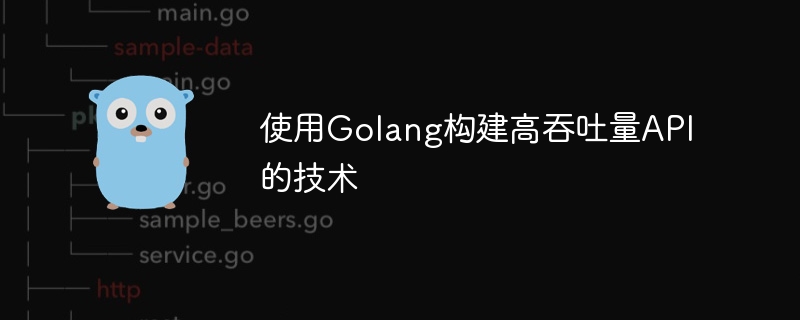Home >Backend Development >Golang >Techniques for building high-throughput APIs using Golang
Techniques for building high-throughput APIs using Golang
- WBOYWBOYWBOYWBOYWBOYWBOYWBOYWBOYWBOYWBOYWBOYWBOYWBOriginal
- 2024-05-07 15:21:01904browse
The key technologies for building high-throughput APIs in the Go language include: Concurrency processing: goroutine achieves high concurrency. Non-blocking I/O: The handler handles other requests while waiting for I/O. Caching: Store common responses to reduce repeated calls. Load balancing: Distribute requests to multiple backend instances.

Techniques for building high-throughput APIs using Go
In today’s fast-paced digital age, it is crucial to build high-throughput APIs to handle large volumes Request and ensure a seamless user experience. The Go language is known for its high concurrency, memory management, and scalability, making it ideal for building high-throughput APIs.
Concurrency processing
Go language achieves high concurrency through goroutine (lightweight thread). Goroutines can run in parallel, taking advantage of multi-core processors.
func handleRequest(w http.ResponseWriter, r *http.Request) {
go func() {
// 执行 I/O 密集型或计算密集型任务
}()
}Non-blocking I/O
The Go language provides non-blocking I/O, which allows a handler to handle other requests while waiting for the I/O operation to complete. By avoiding blocking, the API can handle more simultaneous connections, thereby increasing throughput.
package main
import (
"fmt"
"net/http"
)
func main() {
http.HandleFunc("/", func(w http.ResponseWriter, r *http.Request) {
fmt.Fprintln(w, "Hello, world!")
})
http.ListenAndServe(":8080", nil)
}Caching
Caching can significantly improve the throughput of your API by storing common responses or data to reduce repeated calls to the back-end system. The Go language provides multiple cache implementations, such as sync.Map and third-party libraries go-cache.
var cache = sync.Map{}
func handleRequest(w http.ResponseWriter, r *http.Request) {
data, ok := cache.Load(r.URL.Path)
if ok {
fmt.Fprintln(w, data)
return
}
// 从后端系统获取数据并缓存它
data = fetchFromBackend(r.URL.Path)
cache.Store(r.URL.Path, data)
fmt.Fprintln(w, data)
}Load Balancing
Load balancing is crucial for handling large numbers of concurrent requests. It allows you to distribute requests across multiple backend instances, improving throughput and availability. The Go language provides the net/http/httputil library for configuring reverse proxy and load balancing solutions.
func proxyHandler(w http.ResponseWriter, r *http.Request) {
// 选择后端实例
backend := selectBackend()
// 转发请求到后端实例
proxy := httputil.NewSingleHostReverseProxy(backend)
proxy.ServeHTTP(w, r)
}Practical case
The following is a practical case using Go language to build a high-throughput API:
Problem: Build an application that handles large amounts of image processing The requested API.
Solution:
- Concurrent processing: Use goroutine to process image processing requests from the client in parallel.
- Non-blocking I/O: Use HTTP's ServeMux to handle HTTP requests to avoid blocking.
- Cache: Cache commonly used image transformations to reduce calls to back-end image processing libraries.
- Load Balancing: Deploy multiple API instances and load balance between them to improve throughput.
By implementing these technologies, APIs are able to handle large numbers of concurrent requests while ensuring low latency and high availability.
The above is the detailed content of Techniques for building high-throughput APIs using Golang. For more information, please follow other related articles on the PHP Chinese website!

